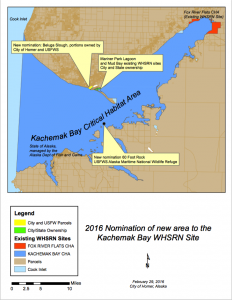Kachemak Bay Birders (KBB) is a key supporter of the Kachemak Bay Western Hemisphere Shorebird Reserve Network (WHSRN) site. KBB has taken the lead in providing monitoring of Kachemak Bay’s spring shorebird migration, keeping the Kachemak Bay WHSRN site online information current, and recently submitted a nomination (which was approved) expanding its size to include most of the city, state, and federal intertidal and open waters in Kachemak Bay previously designated for conservation.
Purpose of WHSRN
- Build a strong system of international sites used by shorebirds throughout their migratory ranges. Currently (July, 2016) the Network has 95 sites in 15 countries, from Alaska in the north to Tierra del Fuego in southern South America.
- Develop science and management tools that expand the scope and pace of habitat conservation at each site within the Network. This is one of the purposes of the KBB’s Kachemak Bay Shorebird Monitoring Project.
- Establish local, regional and international recognition for sites, raising new public awareness and generating conservation funding opportunities. The Kachemak Bay Shorebird Festival, which KBB participates in, is one of the principal means for creating regional awareness in shorebird conservation.
- Serve as an international resource, convener and strategist for issues related to shorebird and habitat conservation. KBB participates in the Alaska Shorebird Group as well as international shorebird conservation efforts.
Source: http://www.whsrn.org/about-whsrn
WHSRN Designation Qualifications:
To qualify for a WHSRN designation, the site’s landowner(s) must agree to:
- make shorebird conservation a priority;
- protect and manage shorebird habitat; and
- keep WHSRN informed of any changes at the site.
WHSRN Categories:
There are three categories of WHSRN Sites and one of Landscapes, according to their importance for shorebirds:
Sites/Landscapes of Hemispheric Importance:
– at least 500,000 shorebirds annually, or
– at least 30% of the biogeographic population for a species
Sites of International Importance:
– at least 100,000 shorebirds annually, or
– at least 10% of the biogeographic population for a species
Sites of Regional Importance:
– at least 20,000 shorebirds annually, or
– at least 1% of the biogeographic population for a species
Kachemak Bay WHSRN Designation
Kachemak Bay is considered a site of International Importance. Kachemak Bay was first designated a WHSRN site in 1995. This 7,260-acre site comprised of parcels on Homer Spit (Mud Bay and Mariner Park Lagoon, owned and managed by the City of Homer) and areas at the head of the bay (Fox River Flats CHA and adjoining parts of Kachemak Bay Critical Habitat Area (CHA) – owned by the State of Alaska and managed by Alaska Department of Fish and Game).
In 2016, KBB organized a WHSRN nomination that included city, state, and federal land owners significantly expanding the Kachemak Bay site to encompass 231,000 acres. The nomination submitted by KBB included Beluga Slough near the city of Homer, the entirety of Kachemak Bay CHA, and Sixty-Foot Rock (a small island owned by USFWS and an important wintering site for Rock Sandpiper and Surfbird). Approval of the nomination was celebrated at the 2016 Kachemak Bay Shorebird Festival with a brief ceremony, which included representatives for each land owner.

More detailed information about the Kachemak Bay WHSRN Site can be found at: Site Profile – http://www.whsrn.org/site-profile/kachemak-bay
Shorebird Monitoring Reports can be found at: http://kachemakbaybirders.org/index.php/citizen-science